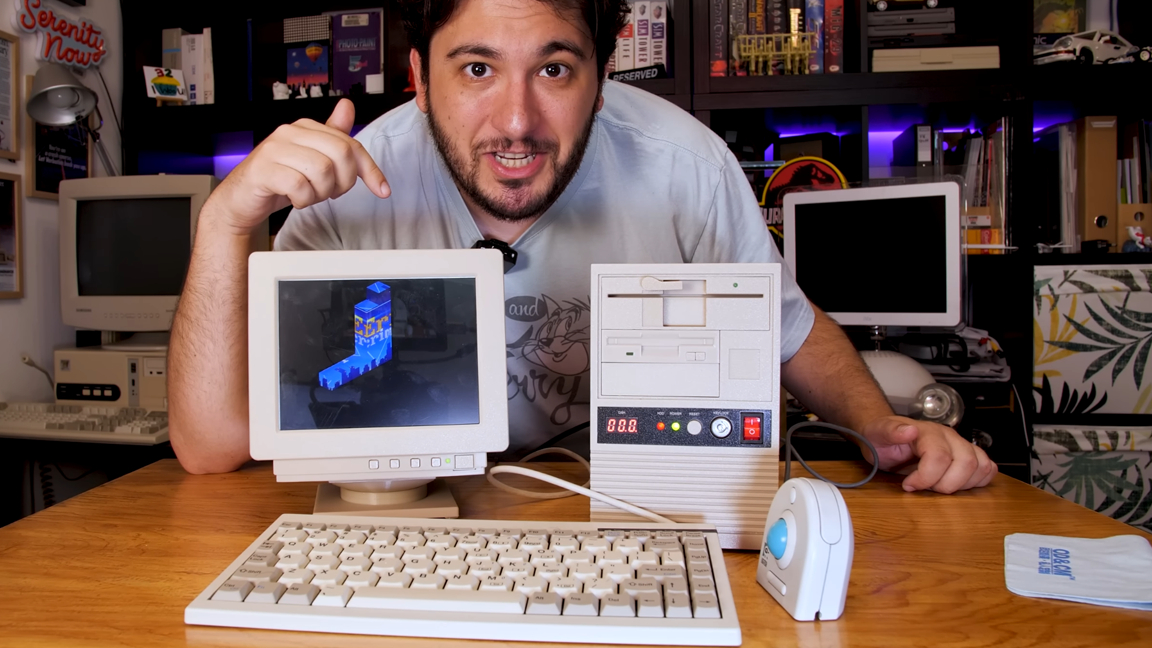Tiny Intel 486 Runs Windows 95 and MS-DOS with Ease at 100 MHz

When it comes to retro computing, you can't beat the look and feel of old hardware. Eric Mackrodt, the mastermind behind the YouTube channel The Eric Experiment, must have had the same thought when he put together this awesome Intel 486 project. It uses original hardware but is housed inside a much smaller, custom case he designed completely from scratch, with a monitor to match!
A project like this takes a lot of planning, from designing the build to sourcing the parts to assemble it. According to Mackrodt, it took him over two years to finish the entire unit. To show off all his hard work, he produced a video and shared it on YouTube detailing all of the components used inside and a peek at the design schematics used in the 3D-printed housing.
Mackrodt explains that the whole PC is based around a small SBC with an Intel 486DX4 CPU with about 100 MHz of power. He is also using a four-slot ISA backplane which has channels for the SBC to connect to along with expansion cards. For graphics, he’s using a Tseng ET4000 video card. In addition, an ESS Audiodrive card is connected for audio support, while an SMC Ethernet card provides network support.
The small monitor is also built from the ground up. It uses an 800 x 600px LCD panel for video output. The shell is based on real-life monitor designs from the era of the Intel 486 and features working buttons and a front-mounted LED used as a power indicator. Both the monitor shell and PC housing are 3D-printed.
With everything assembled, Mackrodt got to the bottom line and showed us how well it runs various operating systems and a few classic games. His rig uses an SD card to act as a hard drive. On this, he first demonstrated Windows 95, on which he successfully completed a game of Solitaire. It also ran Windows 3.11, which was able to support Sim Tower. Lastly, he set it up to run MS-DOS, arguably the best of all three.
If you want to learn more about this project and see it in action (which we highly recommend), check out the original video shared on YouTube by Mackrodt, and be sure to follow him for more cool projects.
Get Tom's Hardware's best news and in-depth reviews, straight to your inbox.

Ash Hill is a contributing writer for Tom's Hardware with a wealth of experience in the hobby electronics, 3D printing and PCs. She manages the Pi projects of the month and much of our daily Raspberry Pi reporting while also finding the best coupons and deals on all tech.
-
Dr3ams Nice! I like it. In the 90s I had a 386, 486 DX and a Pentium 133 MHz.Reply
Also...because there are some games I still want to play, I have Windows 98SE and XP installed in virtual machines.
Some of the games I still play that won't run on Windows 10/11:
- Act of War (XP)
- Red Alert 2 (XP)
- Frogger (Windows 98SE)
- Marble Drop (Windows 98SE)
- Microsoft Arcade (Windows 98SE)
- Think-X (Windows 98SE)
- Yahtzee from Hasbro (Windows 98SE) -
Eximo The headline is weird. Why wouldn't a 100Mhz 486 be able to run Win95 and MS-DOS? Right in the correct era...Reply
Has he not heard of PC104 form factor? Could do it with off the shelf parts if you wanted to. -
bit_user It would've been really nice to include a couple pictures of the guts. I'm not going to watch the Youtube video.Reply
the whole PC is based around a small SBC with an Intel Intel 486DX4 CPU with about 100 MHz of power.
Huh. I had an AMD 486DX4-100. I didn't think Intel made a DX4, though. That was well into the Pentium era, for Intel, which makes me further doubt it.
For graphics, he’s using a Tseng ET4000 video card.
I had one of these. It was an ISA card, though. In the DX4 era, you'd normally have had a VESA Local Bus card or even PCI. IIRC, VLB was like 4x as fast as ISA, but still like half or a quarter as fast as PCI. My DX4 motherboard had PCI, but the weird thing is it was tied to the CPU's base clock. So, that meant it ran at 25 MHz instead of the typical 33 MHz. I think my dad had a Pentium 75, which did the same thing. -
Amdlova My first computer comes from garbage pentium 100 with some edo Ram. The motherboard have jumps to set clock on cpu and pci first interaction with math. Got some overclock from cpu. After I got a p2b with a pentium 2 350 and a voodoo 2 card gold old daysReply -
Eximo I inherited a Pentium 83Mhz overdrive chip in a 486 Zeos desktop. Paradise Pipeline 64 and a Voodoo 2 8MB, at the end I managed to get 4 4mb sticks into that thing.Reply
We had a similar system with the 100Mhz DX in it I think. Bumped it up from a 33 if I recall. I don't remember what the original processor in my 486 was, might have been a 66mhz. I know we had more 486 processors than computers. Probably sitting in a drawer somewhere, just know that my brother bought himself a PII and Matrox card and gave me the Pentium. Not that I kept it too long. AMD K6 sometime after that. Man the jumps in performance were staggering back then. -
JamesJones44 Replybit_user said:I didn't think Intel made a DX4, though
They did manufacture a DX4 100 and 75. They didn't sell all that well in OEM form because the Pentium 60 and 66 were quicker in most benchmarks for about the same price. It also didn't help that the Intel DX4 came out after the Pentium 60 and 65 were released. -
Alvar "Miles" Udell My first Windows computer had a 75mhz AMD K5 and 8MB RAM, ESS audio, S3 Virge DX GPU, 600mb HDD, ran Windows 95, and was able to play Doom and navigate the internet with dial up, just like thousands of others did in the mid 90s.Reply
It's a nice project though. -
blppt ReplyEximo said:The headline is weird. Why wouldn't a 100Mhz 486 be able to run Win95 and MS-DOS? Right in the correct era...
Has he not heard of PC104 form factor? Could do it with off the shelf parts if you wanted to.
Exactly. I ran Windows 95 on a 486SX-25 back in the day. It didn't run GREAT, but it got the job done.
DX4/100 was a dream for me. -
blppt ReplyHuh. I had an AMD 486DX4-100. I didn't think Intel made a DX4, though. That was well into the Pentium era, for Intel, which makes me further doubt it.
Intel actually released their DX4/100 first---I think you are remembering the AMD DX4/120, which Intel never made a 486 chip that fast. -
blppt Reply
IIRC, VLB's problem wasn't that it was significantly slower than PCI, it was that its clock speed was locked to the bus speed, meaning that for certain CPUs like the DX50 (not DX2), it would be problematic running a VLB card at that bus speed (obviously the clock multiplier DX2 50-66-75-100 would operate at 25 or 33mhz bus, and not suffer that problem).bit_user said:bit_user said:I had one of these. It was an ISA card, though. In the DX4 era, you'd normally have had a VESA Local Bus card or even PCI. IIRC, VLB was like 4x as fast as ISA, but still like half or a quarter as fast as PCI.
PCI, on the other hand, had a locked clock speed of 33mhz. Also, the connectors for VLB were downright massive in comparison.
